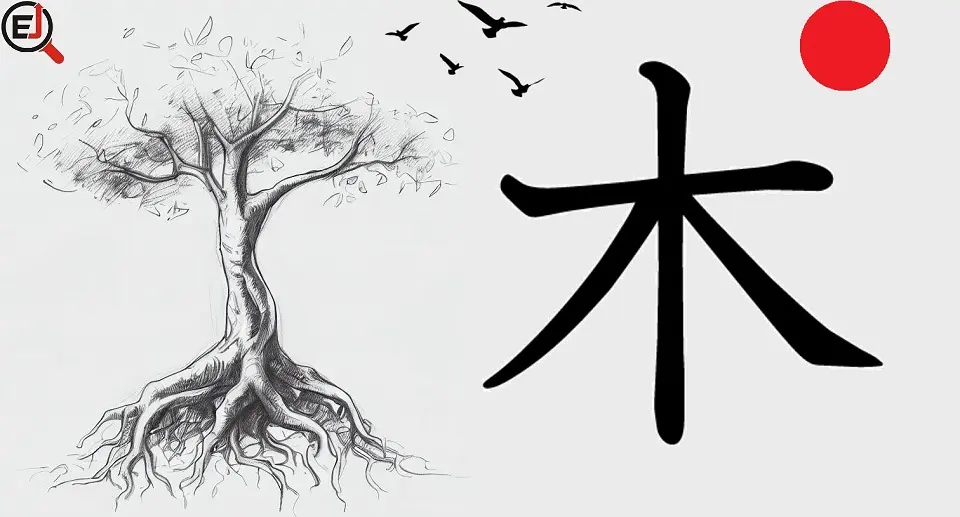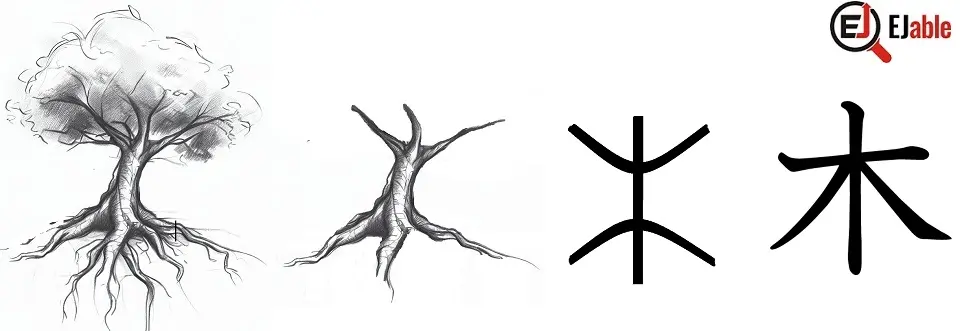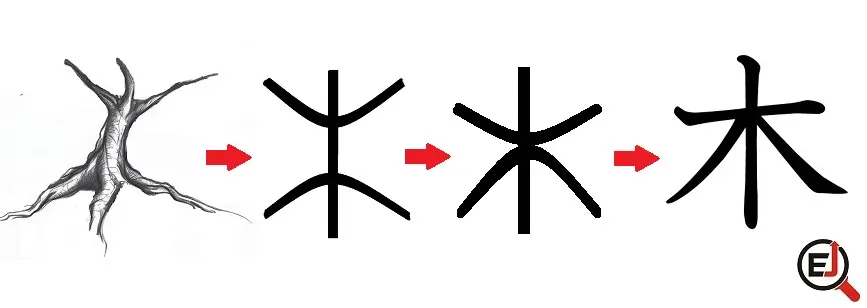Kanji for Tree or Wood (木, Ki)

The Japanese kanji for “tree” is 木. The Kunyomi or the Japanese pronunciation of the Kanji 木 is “ki” (き) or “ko” (こ), and the Onyomi (Chinese) pronunciation is “boku” (ボク) or “moku” (モク).
In compounded words, the pronunciation is often changed to “gi,” “moku,” “boku,” “ko,” or “mo.” An example of such words that most foreigners know is the Roppongi area of Tokyo, which is famous for its nightlife and foreign embassies. The Kanji of Roppongi is 六本木, and it means “Six Trees.”
The tree’s Kanji is constructed with 4 strokes. This Kanji is a part of the JLPT N5 syllabus (please check the JLPT N5 Kanji list). In Japanese schools, this Kanji is taught in grade 1.
Symbolism
The kanji for the tree serves as a symbol for many aspects connected to life, nature, and growth. It carries the essence of life, growth, firmness, and resistance. It also evokes the notions of strength and flexibility we often attribute to trees.
Origin of the Shape of the 木
The origin of this kanji is quite straightforward. A simple pictograph in oracle bone script, the oldest known form of Chinese writing, depicted a tree with roots, a trunk, and branches. Over time, the picture was simplified and standardized into the character we see today.
In seal script, an ancient Chinese calligraphy style, the character was further abstracted but still resembles a tree with branches. This script directly precedes the modern form, or kaisho, used in today’s kanji.
Mnemonic: How to Remember the Kanji of Tree (木)
The Kanji for the tree or wood 木 is very easy to remember. To remember this kanji, please break it into two parts as follows:
- Consider that the three lower lines represent the roots of the tree
- The horizontal line and the top part of the vertical line above the horizontal line represent the tree branches.
Please check the following illustration, which will explain the above fact and will also help you remember the Kanji of the tree quickly:


You may think that the lines of strokes representing the branches do not look like the tree’s branches. However, please note that the characters of Kanji scripts have evolved over time, and the modern Kanji characters have been simplified to a great extent for ease of writing.
Please check the following illustration, which explains the journey of simplification of “Ki” of the tree Kanji:


木 in Compounded Japanese Words
The Kanji for the Tree frequently appears in compounded Japanese words’ kanjis. There are 258 Japanese words that begin with the Kanji 木, and it appears in 691 words.
Examples of Kanji 木 in Compounded Kanji Characters
Following are the examples where Kanji for tree appears in Japanese compounded Kanji characters:
- 六本木 (Roppongi): Name of the place, meaning “6 trees”.
- 本木 (もとき, motoki): Original stock.
- 木刀 (ぼくとう, bokutō): Wooden sword.
- 木偶 (でく, deku): Wooden doll, wooden figure, puppet, blockhead, good-for-nothing, fool.
- 土木 (どぼく, doboku): Engineering works, civil engineering, public works.
- 木石 (mokuseki): trees and stones, natural features.
- 木綿 (momen): cotton.
- 木枯らし (kogarashi): winter wind, tree-withering wind.
- 木漏れ日 (komorebi): sunlight filtering through trees.
- 木陰 (kokage): shade of tree.
- 木々 (kigi): trees, every tree.
- 石木 (seki-boku): stones and trees, inanimate objects.
- 青木 (aoki): a common family name literally meaning “green tree.”
- 木金 (mokkin): Thursday and Friday, end of the week
- 木立 (kodachi): grove, copse, thicket.
木 as a Radical
Tree’s Kanji appears as a radical or component in 1340 Kanji characters, including 176 Jōyō Kanji.
As a Kanji radical, 木 is employed in many other characters to impart meanings related to plant life, nature, or wood. Variations of this radical include 森 (a forest or many trees) and 林 (a grove or small woodland).
Examples of 木 as radical in other Kanji Characters
Following are some examples of kanji where the radical for “tree” (木) is used:
- 材 (zai): Lumber; material
- 木材 (もくざい, mokuzai): Lumber; timber; wood.
- 林 (はやし, hayashi): Grove (small woods); a group of trees
- 森 (もり, Mori): Forest; woods
- 林業 (ringyou): Forestry
- 校 (kou): School; proof (the radical 木 is a variant here)
- 植 (shoku): To plant; to grow
- 果 (ka): Result, Attained state, Enlightenment, Counter for pieces of fruit
- 果物 (kudamono): Fruit
- 村 (mura): village
- 村人 (murabito): villager
- 桜 (さくら, Sakura): Cherry tree; cherry blossom, decoy; fake buyer; hired applauder
- 桜花 (おうか, ouka): Cherry blossom flowers
- 板 (ita): board; plank
- 柱 (hashira): pillar; post
- 棋 (ki): Shogi; chess
- 椅子 (isu): Chair
- 楽 (raku): Music; pleasure (the radical 木 is a variant here)
- 楽器 (gakki): Musical instrument
- 板金 (itakane): Sheet metal
- 柱時計 (hashira-dokei): Grandfather clock
- 棋譜 (kifu): Game record (in shogi, go, etc.)
- 検 (ken): To inspect; to examine
- 検査 (kensa): Inspection, examination
- 権 (ken): Rright; authority
- 権力 (kenryoku): Power, authority
The kanji characters above show the “tree” radical in various positions and forms. In some characters, the radical may not look exactly like 木, but its presence is part of the kanji’s formation history.
Difference Between 木材 and 材
The difference between 木材 (もくざい, mokuzai) and 材 (ざい, zai) in Japanese lies in their specificity and context of use:
- 木材 (もくざい, mokuzai):
- 木材 (もくざい, mokuzai) specifically refers to “wood” or “lumber.”
- It denotes wood as a material, usually in the context of construction, carpentry, or manufacturing.
- The 木 in 木材 emphasizes that the material is wood, as 木 means “tree” or “wood.”
- 材 (ざい, zai):
- 材 (ざい, zai) is a more general term that can mean “material” or “timber.”
- It is used to refer to any kind of material, not just wood, and is often seen in compound words.
- 材 can be combined with other kanji to specify the type of material, such as 鉄材 (てつざい, tetsuzai) for “iron material” or 石材 (せきざい, sekizai) for “stone material.”
In summary, 木材 is specifically used when referring to wood or lumber. At the same time, 材 is a broader term that can refer to various types of materials, including but not limited to wood.
Compounded Words with Tree’s Kanji and Radical of 木
You will find it interesting that in many examples above, the radical of Ki (木) appears with the whole Kanji of the tree. Some such examples are 木材 (Lumber, timber, wood) and 木枯らし (winter wind, tree-withering wind).
You may also like to check other Kanji characters on the page “How to Learn Kanji“.


A long-term ex-pat in Japan, Himanshu comes with an IT background in SAP consulting, IT Business Development, and then running the country operations of an IT consulting multinational. Himanshu is the co-founder and Managing Director of ReachExt K.K. and EJable.com. He is also an Advisory Board Member of a Silicon Valley AI/IoT startup.

